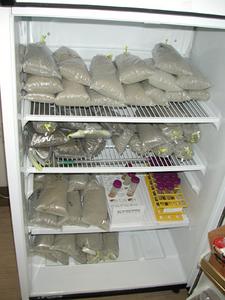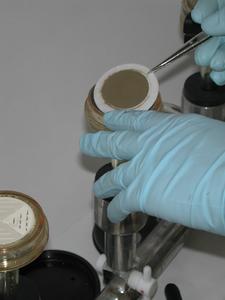9 December, 2002
Processing Samples
Today we will begin to process some samples. We want to see if there are any
yeast organisms in the soil samples we have collected. How would you go about
determining if there are any yeast organisms growing in the soils? Share your
ideas with your friends. Then check your ideas with what we are doing in the
Carry Lab.
Here's what we did:
Weigh our 100 grams to bake in an oven to determine moisture content.
Weigh out 20 grams and mix with sterile water in a 50 ml Falcon tube. Keep on
ice. Prepare the filter system with a black filter (because the yeast will look
whitish) and a pre-filter to catch soil parcticles. Just before filtering shake
several times. (Why do we do this?) Using a pipette, suck up 20 mils of the
water from the falcon tube and put into the filter system. Turn on the vacuum
pump and filter fluids. Then remove pre-filter and put the actual filter on the
growth plate with yeast food in it. Put in incubator and leave for a week at 15
degrees Celsius. Here are some pictures of the process.

Dr.Laurie Connell is weighing each sample carefully

Samples kept on ice until they are filtered. Rusty takes 20 grams of soil, adds sterile water to about 45 mils and places the sample on ice until we can filter them. Each sample is carefully labeled. All samples are processed quickly.

A peek into the 15 degree Celsius incubator. Notice all of our samples from the first transect. We will use some sample from each bag, the rest will be kept for future use.

Preparing the filter system. Dr. Redman is finally ready to start processing the samples. She places a filter on top of the system, then places a pre-filter over the filter. This is to catch the larger parcticles that slip through.

We can each process three samples at a time. We put 20 mls of sample into a filer, do the same for two more filters, then turn on the vacuum pump which sucks all of the water through the system. Then we open the system, and remove the pre-filter.

Carefully removing the filter, we place it into a growth media dish.

Placing the filter on the labeled growth media plate Why do you think we selected black grid filters for this experiment? what do you think we will find? Why will we set the incubator at 15degrees Celsius? Should we label the plate first, or place the sample in the plate first? share your ideas with your friends.

Baking the samples in an oven is one way to determine the amount of moisture in the soil sample. Here Dr.Connell is working with one set of samples. Each dish is weighted and labeled. How can you determine the amount of moisture in any soil sample? How much water do you think we will find in this polar desert soil sample?
Contact the TEA in the field at
.
If you cannot connect through your browser, copy the
TEA's e-mail address in the "To:" line of
your favorite e-mail package.
|
